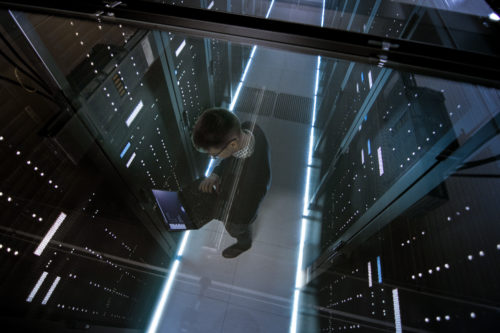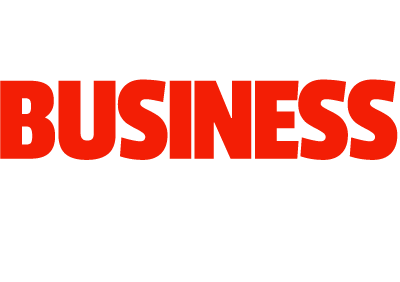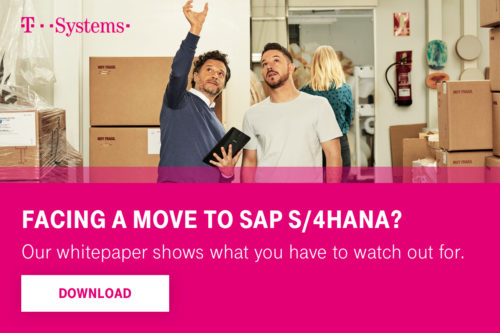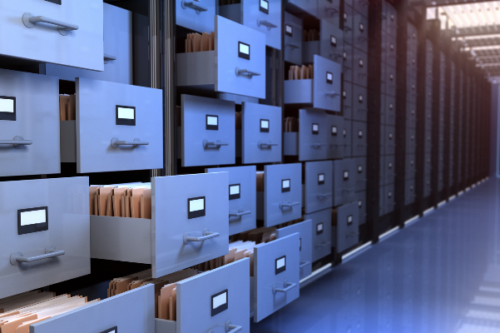Where do legacy systems go after migration to SAP S/4HANA?
SAP S/4 HANA is a true real-time ERP suite with rapid process execution and analytics. A major challenge in migrating to SAP S/4 HANA is the question: what happens to the legacy data? The Managed Application Retirement Services from T-Systems are the cost-efficient answer to this question.
Companies have a history. Relationships with customers, partners and suppliers have to be documented over a prolonged period of time, just as invoices. If you don’t know what happened in the past, you’re not going to be successful in the future. All documents have a life cycle from their creation up to their legally required deletion.
The deletion of critical or sensitive data can be just as important as the “historization“ as provided by T-Systems Managed Application Retirement Services (M.A.R.S.) for the tamper-proof archiving of legacy data in the cloud.
In this process of historization legacy data is cleared and old systems are decommissioned. This is not an actual migration. M.A.R.S. services ensure a minimum of data is taken over and the rest of the files historized in compliance with laws and regulations.
Advantages and benefits of S/4HANA
Historization of older documents or data inventories brings advantages not only to mergers and acquisitions (M&As), but also for the migration to new systems such as SAP S/4HANA. The conversion to the new, cloud-based real-time SAP ERP suite is already underway or at the preparation stage in many large enterprises and is one of the most important IT projects worldwide. Companies feel price pressure or increasing costs as well as the increasing disruption in many areas combined with the continuing scarcity of skilled employees and the threats of an economic downturn. This can be easily learned from corporate websites, press articles and ad hoc announcements by the top 100 companies in Germany. This article in the renowned business publication Handelsblatt points to similar challenges for the top 100 group companies in Germany.
SAP has pledged that support for the current SAP Business Suite will continue up to 2025 but after that all corporate customers have to migrate their ERP suites to SAP S/4HANA with the column-based rather than line-based in-memory real-time database SAP HANA in the cloud. The initial to this migration challenge response was slow, but now a lot of large companies including many of the top 500 have already converted or are in the process of doing so.
Archiving for ten years or eternity
Legal requirements have to be observed. Every German businessman knows that, according to Section 257 of the German Commercial Code (Handelsgesetzbuch, HGB), all ledgers or account books, group reports, consolidated financial statements, accounting receipts etc. have to be archived digitally or in the original for ten years or permanently. For other business documents, an archiving period of at least six years applies. In some sectors, for example hospitals or in schools in Bavaria documents have to be preserved for up to 40 or 50 years.

This is one of the main reasons why many companies shy away from replacing their legacy systems. “Never touch a running system” is more than just a slogan. The average age of the ERP installations in the German-speaking countries is five years and more in around 75 percent of cases, explained Tibor Kosche, Vice President and Managed Application Retirement Services (M.A.R.S.) of T-SYSTEMS DATA MIGRATION CONSULTING AG, recently an article in M&A Review (edition March, page 84). He said that there are still many older business software products such as IBM Lotus Notes, do-it-yourself solutions and obsolete hardware drivers for which the support has expired. All of this can pose high security risks combined with obsolete infrastructure.
Who is still using Cobol and Co.?
This also increases the pressure to transfer the data in line with the legally prescribed periods in such a way that they comply with the various laws and the data protection regulation in accordance with GDPR. This is a major challenge for migration, as is the continuing scarcity of skilled employees. It also means, however, that the company cannot avoid migrating to more modern systems. Because who still even knows how to use older programming languages such as Cobol, Pascal or Fortran? The people who still can are generally of more advanced age, and often not even working for their respective companies anymore. Do these now have to be brought back for the processing and the maintenance of the data? This is why the standardization of the ERP landscape with a cloud-based system such as SAP S/4HANA is an urgent requirement.
According to T-Systems manager, Kosche, every migration strategy has to begin with establishing the assets and identifying the pain points. The pain points include the aforementioned legacy systems, the continuation of which can involve high costs due, among other things, to the lack of expertise available.
Historization versus archiving
There are two ways of transferring the data safely: one is archiving, where selected data sets are moved out in such a way that they can only be accessed when they are required. Data recovery can be very complicated and cost-intensive. There is also the risk that after 30 or 50 years there may no longer even be devices in which the original data carriers can be used. For data that only have to be kept due to the legal stipulations, large cloud providers also offer so-called “cold storage” solutions on the cloud.
The historization as practiced by T-Systems with M.A.R.S. and offered as end-to-end managed services is aimed at shutting down the post-productive old systems and transferring all the relevant data to a modern, more cost-efficient system. This requires an in-depth understanding of the data logic of the applications, however complex they may be. Although historization solutions are available on an on-premises basis, T-Systems recommends the cloud.
Full-text database search provided by SAP S/4HANA via private or public cloud makes it possible to access the old data or data sets anytime. There is also the option of separating the old systems from proprietary hardware and transferring them to the cloud. This has the advantage that the users can continue to use their accustomed environment. The disadvantages of this “Wrapping Legacy in the Cloud” can be considerable costs and the risk of brain drain when trained employees leave the company.
The challenge of standardizing systems
The globally recognized brand Henkel stands for innovative strength and agility. And that also applies to the in-house IT department of the company. But even Henkel had to struggle with the typical challenges in the introduction of worldwide, reliable standards: heterogeneous IT environments, different release statuses or, for example, globally distributed systems and applications. Sven Schweden, manager of the Information Lifecycle team and responsible for the decommissioning of old systems at Henkel, describes the project:
“We started project Horizon as far back as 2010 in order to reduce the 33 ERP systems we had in operation worldwide at the time to just one. We were faced with the question: what are we going to do with the 70 terabytes of data buried in our old systems? Transferring the information from the old systems to the new central solution would have been too complicated. But continuing to operate the old system at the lowest possible operating temperature did not, on closer examination, appear to make sense. Because even in a deep sleep with access for normal users and interface to third-party applications capped, the old systems still have to be maintained,” .
Together with T-Systems Henkel developed a solution that offered both legal compliance as well as the option of shutting down the old systems. And this was the path that the company chose.
Source picture: iStock / kbeis
[plista]




